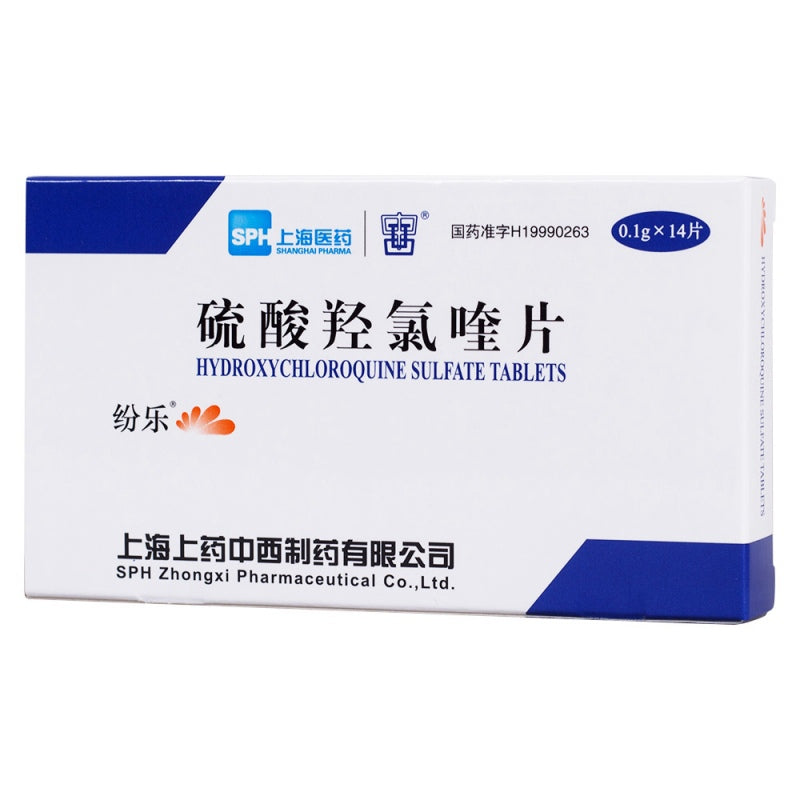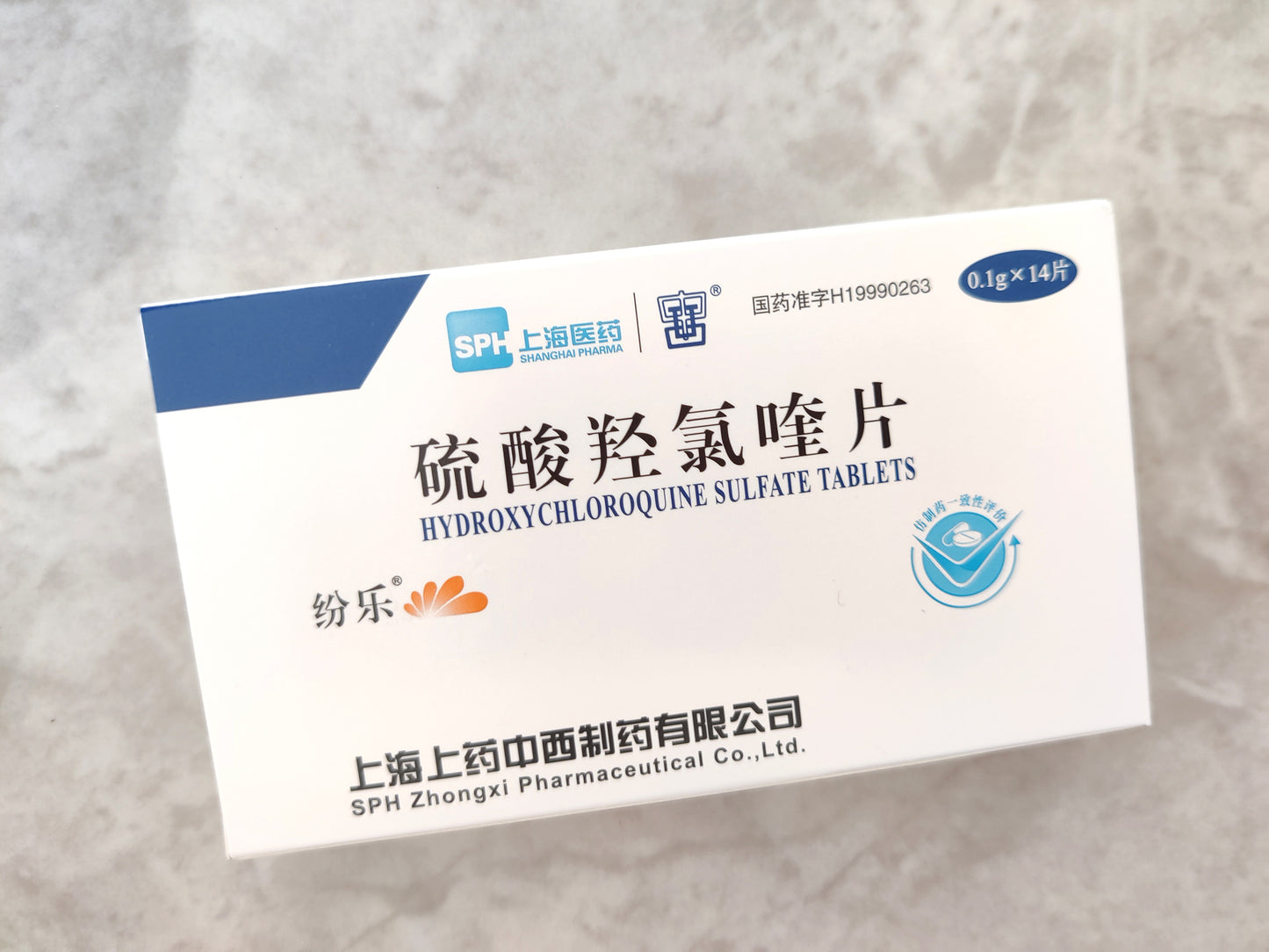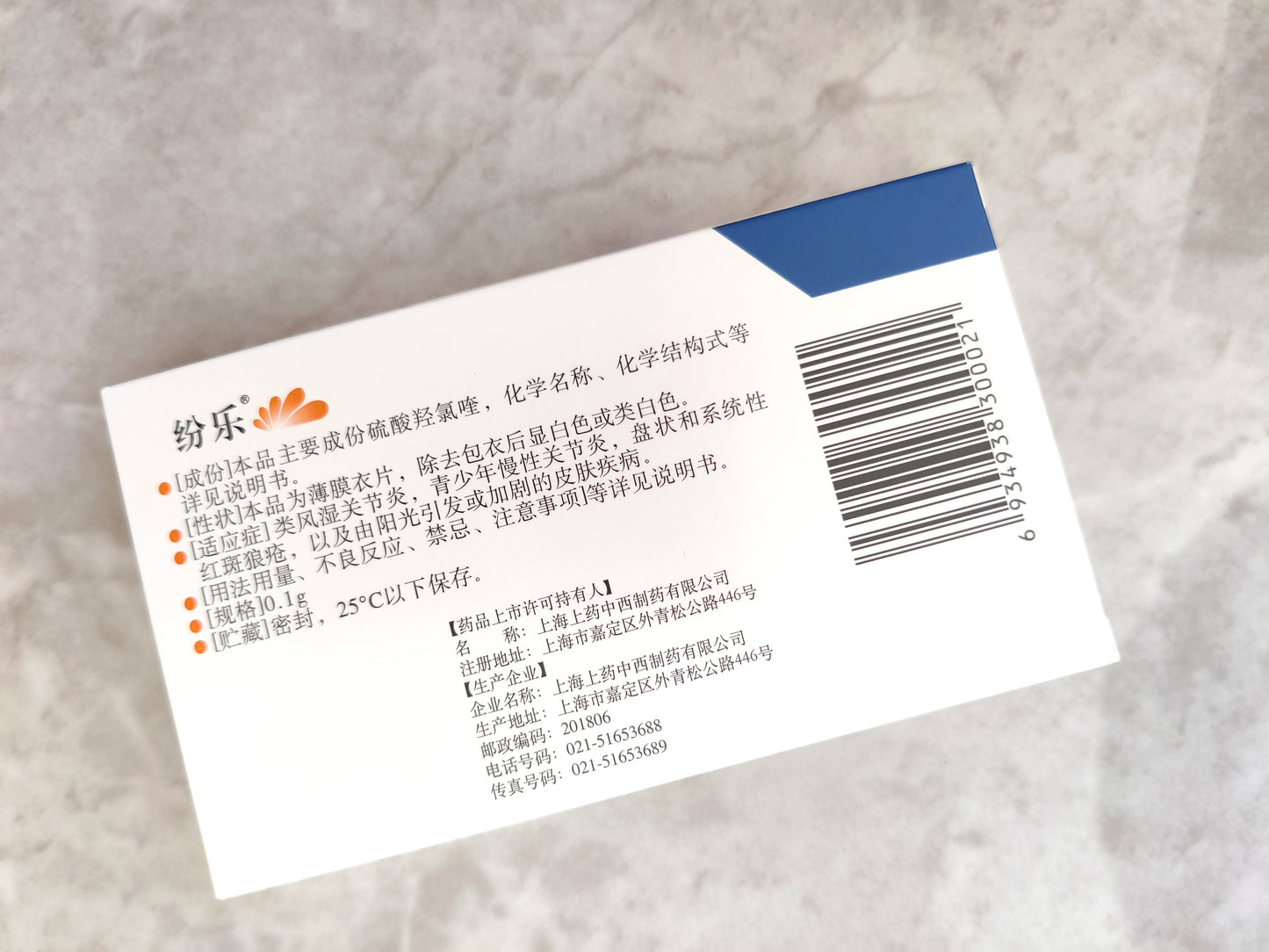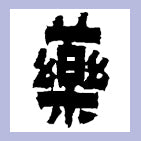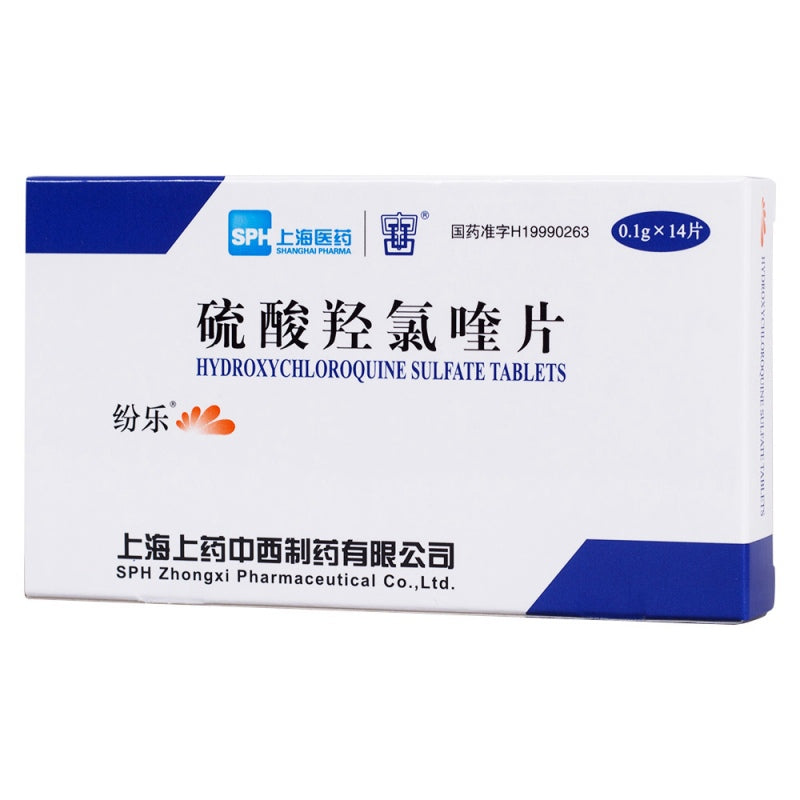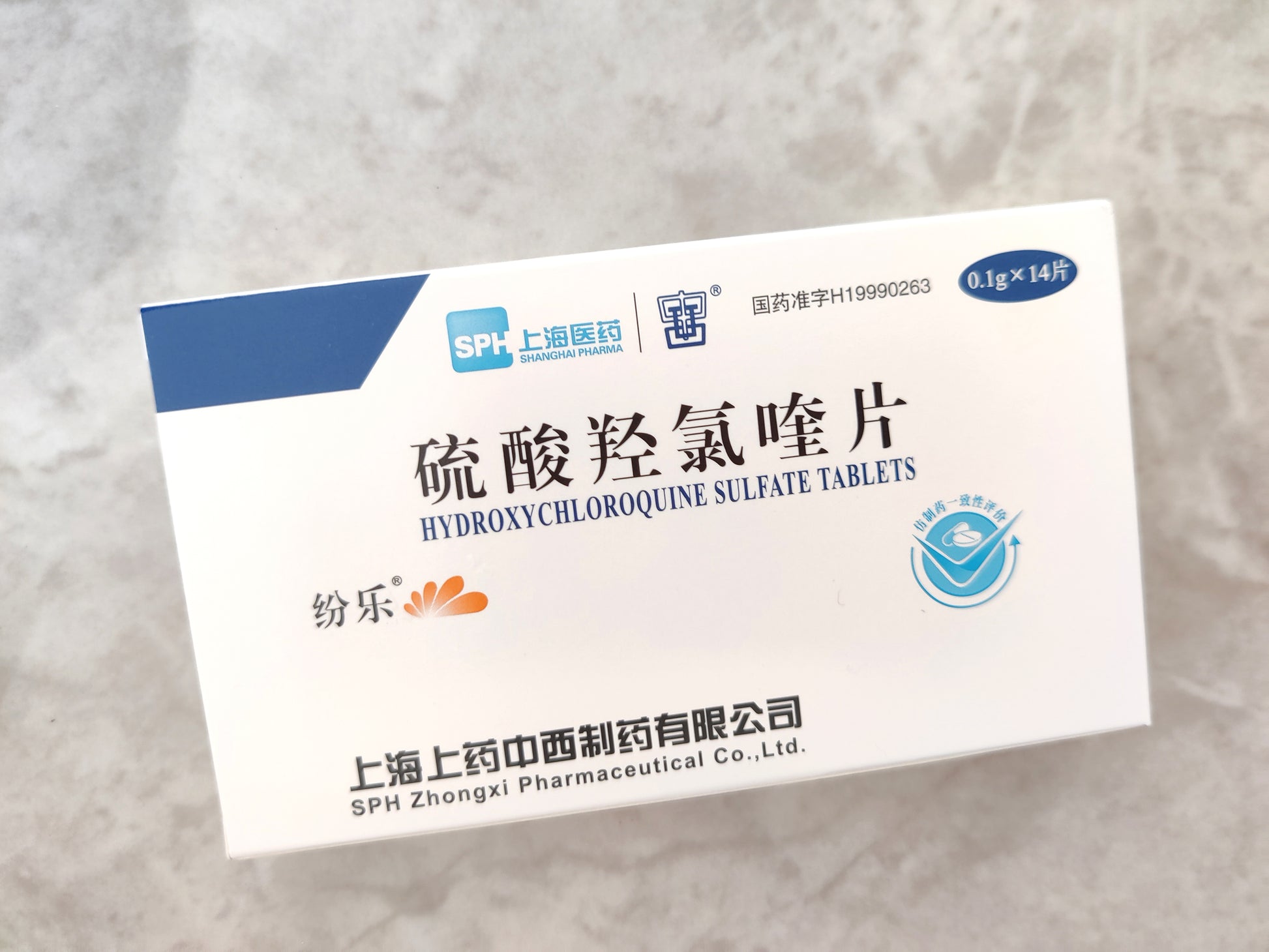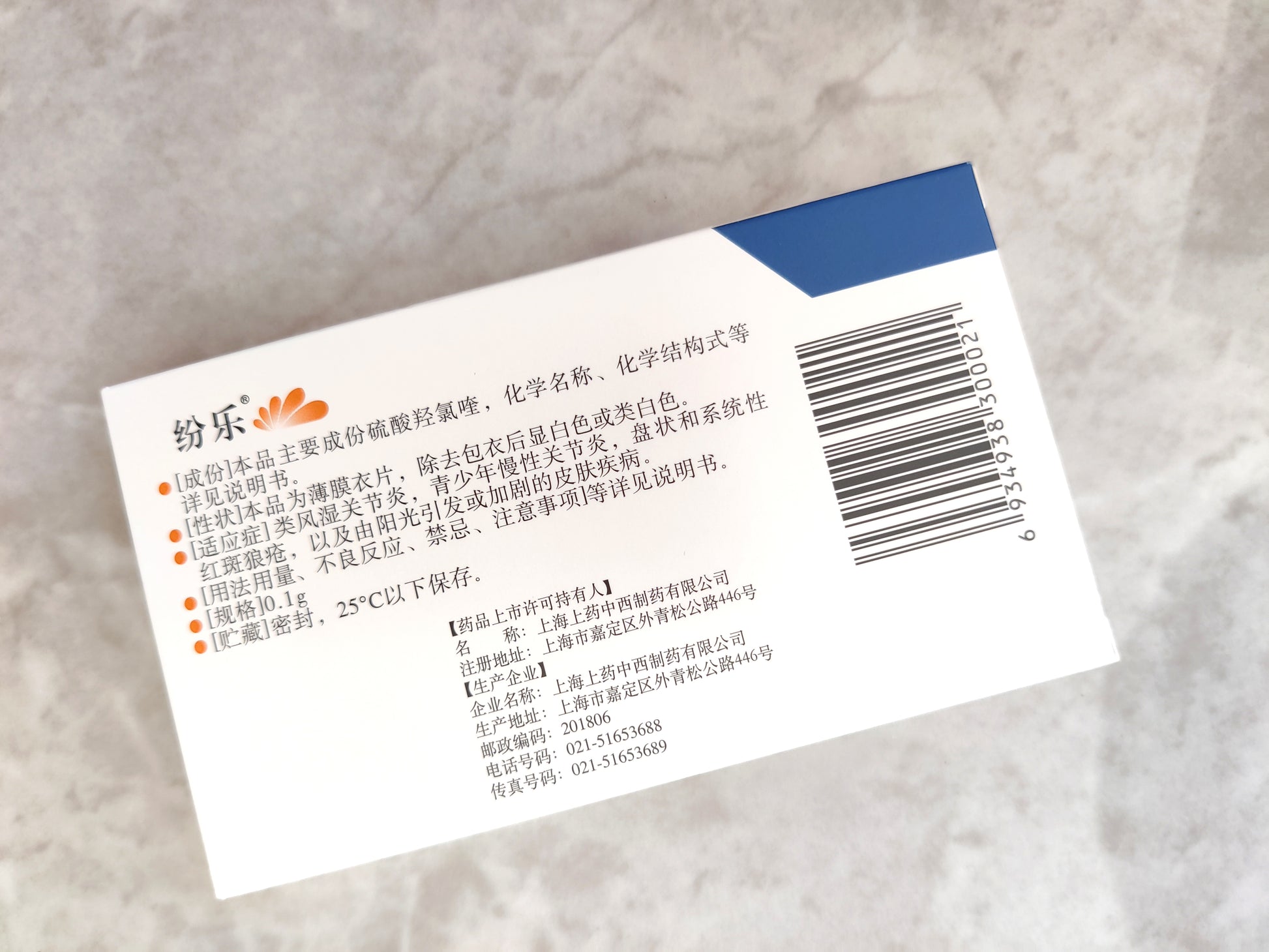SPH Zhongxi Pharmaceutical Co., Ltd
硫酸羟氯喹片, Hydroxychloroquine Sulfate Tablets, Liusuan Qianglvkui Pian, 0.1g*14 Tablets
硫酸羟氯喹片, Hydroxychloroquine Sulfate Tablets, Liusuan Qianglvkui Pian, 0.1g*14 Tablets
无法加载取货服务可用情况
Medication Name
Hydroxychloroquine Sulfate Tablets
(Liu Suan Qiang Lv Kui Pian)
Ingredients
The main ingredient of this product is hydroxychloroquine sulfate, with the chemical name: 2-[[4-[(7-chloro-4-quinolinyl)amino]pentyl]ethylamino]ethanol sulfate. Chemical structure: Molecular formula: C18H26ClN3O·H2SO4; Molecular weight: 433.96.
Properties
This product is a film-coated tablet that appears white or nearly white after removing the coating.
Indications
This product is used for the following conditions when response to medications with potentially serious side effects is unsatisfactory: rheumatoid arthritis, chronic arthritis in adolescents, discoid lupus erythematosus, systemic lupus erythematosus, and skin lesions caused or exacerbated by sunlight.
Dosage and Administration
Oral Administration
For adults (including the elderly), the initial dose is 0.4g per time, taken in divided doses. When further improvement in efficacy is no longer observed, the dose may be reduced to 0.2g for maintenance. During maintenance, if the therapeutic response diminishes, the maintenance dose should be increased to 0.4g daily. The smallest effective dose should be used for maintenance and should not exceed 6.5mg/kg/day (calculated based on ideal body weight rather than actual body weight) or 0.4g/day, or even less.
Each dose should be taken with a meal or milk.
Hydroxychloroquine has a cumulative effect and takes several weeks to exert its beneficial effects, while mild adverse reactions may occur relatively early. If there is no improvement in rheumatic diseases after 6 months of treatment, treatment should be discontinued. When treating photosensitivity diseases, treatment should only be given during maximum exposure to sunlight.
Adverse Reactions
According to foreign literature reports, the following adverse reactions do not occur with long-term use of every 4-aminoquinoline compound, but have been reported in one or more drugs, so attention should be paid when using this class of drugs. The types and frequencies of adverse reactions vary among different compounds.
Central Nervous System Effects: Irritability, neuroticism, mood changes, nightmares, psychosis, headache, dizziness, vertigo, tinnitus, nystagmus, sensorineural hearing loss, convulsions, ataxia. Although rare, the above adverse reactions have been reported in foreign literature.
Neuromuscular Effects: Skeletal muscle paralysis or myopathy or neuromyopathy leading to progressive weakness and proximal muscle atrophy, which may be accompanied by mild sensory abnormalities, decreased tendon reflexes, and abnormal nerve conduction.
Ocular Effects:
- Accommodation disorders of the ciliary body may result in blurred vision, which is dose-dependent and reversible upon discontinuation.
- Cornea: Transient corneal edema and opacity, decreased corneal sensitivity. Symptomatic or asymptomatic corneal changes (blurred vision, halos, photophobia) are common but reversible. Corneal deposits may appear as early as 3 weeks after starting medication. However, the incidence of corneal lesions and visual adverse reactions with hydroxychloroquine is much lower than with chloroquine.
- Retina: Macular edema, atrophy, abnormal pigment deposition (ranging from mild punctate deposition to diffuse), loss of foveal reflex, prolonged recovery time of the macula after exposure to bright light (light stress test), increased threshold to red light in the macula, parafoveal, and surrounding retinal areas. Other fundus changes include pale and atrophic optic discs, narrowed retinal arteries, granular pigment deposition around the retina, and choroidal changes (convex choroid) during disease progression.
- Visual Field Defects: Paracentral scotomas, central scotomas, and decreased visual acuity. Rarely, there may be narrowing of the visual field and color vision abnormalities.
Skin Reactions: Hair whitening, alopecia, pruritus, skin and mucosal pigmentation changes, photosensitivity, and skin lesions (urticaria, polymorphous erythematosus, lichenoid changes, maculopapular rash, purpura, centrifugal annular erythema, Stevens-Johnson syndrome, acute generalized exanthematous pustulosis, and exfoliative dermatitis).
Hematological Effects: Various hematological abnormalities such as aplastic anemia, agranulocytosis, leukopenia, anemia, and thrombocytopenia (hemolysis in patients with G-6-PD deficiency).
Gastrointestinal Effects: Anorexia, nausea, vomiting, diarrhea, and abdominal spasms may occur. There have been reports of abnormal liver function and even cases of fulminant hepatic failure in foreign literature.
Allergic Reactions: Urticaria, angioedema, and bronchospasm have been reported in foreign literature.
Cardiovascular Effects: Cardiomyopathy is rarely reported and only occurs in patients receiving high doses of hydroxychloroquine. Chronic toxicity should be suspected when cardiac conduction abnormalities (bundle branch block/atrioventricular block) and bilateral ventricular hypertrophy are found. Discontinuation may lead to recovery.
Other Effects: Weight loss, fatigue, porphyria, and exacerbation of psoriasis that is not photosensitive.
Contraindications
- Patients with retinal or visual field changes that can be caused by any 4-aminoquinoline compound treatment are prohibited from using this product.
- Patients with known allergy to 4-aminoquinoline compounds are prohibited from using this product.
- Pregnant and lactating women are prohibited from using this product.
Precautions
(1) Keep this product out of the reach of children.
(2) The use of this product may exacerbate psoriasis and porphyria. Therefore, this product should not be used in these patients unless the benefits to the patient, as judged by the physician, outweigh the possible risks.
(3) Physicians should be fully familiar with the entire contents of this package insert before prescribing this product.
(4) Irreversible retinal damage has been observed in some patients receiving long-term or high-dose treatment. It is reported that retinal changes are dose-related.
(5) Patients taking this product should undergo initial (baseline) and regular (every 3 months) ophthalmic examinations (including visual acuity, slit-lamp biomicroscopy, funduscopy, and visual field testing).
(6) If there are any abnormal signs in visual acuity, visual field, or macular area of the retina (such as pigmentation changes, loss of foveal reflex) or any visual symptoms (such as flashes and streaks) that cannot be fully explained by accommodation difficulties or corneal opacity, the medication should be discontinued immediately and closely monitored for possible progression. Even after discontinuation of treatment, retinal changes (and visual impairments) may still progress.
(7) All patients receiving long-term treatment with this product should be followed up and examined regularly, including checking knee and ankle reflexes and any signs of muscle weakness. If muscle weakness is found, the medication should be discontinued.
(8) This product should be used with caution in patients with liver disease or alcoholism, or when combined with drugs known to have hepatic toxicity.
(9) Regular blood cell counts should be performed on patients receiving long-term treatment with this product. If any severe hematological disorders occur that cannot be attributed to the treated disease, discontinuation of the medication should be considered. Patients lacking G-6-PD (glucose-6-phosphate dehydrogenase) should use this drug with caution.
(10) Skin reactions may occur with this product, so appropriate caution should be taken when administering this product to any patient receiving medications with a clear tendency to cause dermatitis.
(11) The recommended methods for early diagnosis of "hydroxychloroquine retinal lesions" include ① using funduscopy to check for subtle pigment disturbances or loss of the foveal reflex in the macula and ② using a small red target to check for central, pericentral, or central scotomas in the visual field or to determine the threshold for red retinal light. Any unexplained visual symptoms such as flashes or streaks should also be suspected as possible manifestations of retinal lesions.
(12) In cases of severe toxic symptoms due to overdose or allergy, oral ammonium chloride (8g daily in divided doses for adults, for 3 or 4 days a week) is recommended for several months after discontinuing treatment, as acidification of urine can increase renal excretion of 4-aminoquinoline compounds by 20% to 90%. However, caution should be exercised in patients with renal impairment and/or metabolic acidosis.
Medication for Special Populations
Precautions for Children
Currently, there have been no systematic and reliable clinical trials conducted in China on the use of this medication in children. The effectiveness and safety of this medication in children have not been established, therefore, it is not recommended for use in children.
Precautions for Pregnancy and Lactation
Hydroxychloroquine can cross the placenta. Limited information is available regarding the use of hydroxychloroquine during pregnancy. It should be noted that therapeutic doses of 4-aminoquinoline are associated with central nervous system damage, including its toxicity (auditory and vestibular toxicity, congenital deafness), retinal hemorrhage, and retinal pigmentation. Therefore, pregnant women should avoid using hydroxychloroquine, and it should only be used when the physician determines that the benefits of prevention and treatment with this medication outweigh the possible risks. After intravenously injecting radiolabeled chloroquine into pregnant CBA mice, the drug quickly crossed the placenta and selectively accumulated in the melanin structures of the fetal eyes, remaining in the ocular tissues for 5 months after the drug was eliminated from other parts of the body. Lactating women should use hydroxychloroquine with caution as small amounts of hydroxychloroquine can be secreted into breast milk, and it is known that infants are very sensitive to the toxic effects of 4-aminoquinoline.
Precautions for Elderly
No such studies have been conducted, and there are no reliable references available.
Drug Interactions
Not yet clear.
Pharmacological Effects
This product is a 4-aminoquinoline drug used to treat discoid lupus erythematosus and systemic lupus erythematosus. Its mechanism of action is unclear, but it is currently believed to be related to its immunosuppressive and anti-inflammatory effects.
Storage
Store in a light-protected, sealed container.
Specification
0.1 grams
Packaging Specification
Aluminum-plastic board packaging; 14 tablets per box.
Expiration
36 months.
If you are seeking additional discounts or have an interest in purchasing other Chinese medications, please feel free to contact us at any time. We are fully dedicated to offering you comprehensive services tailored to your individual needs.
Share
